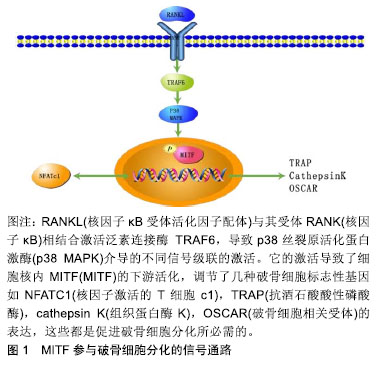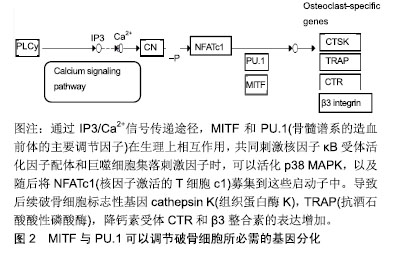| [1] |
Wei Congcong, Yao Mengxuan, Yang Meng, Li Huijie.
Mechanism and treatment of osteolysis around artificial joint prosthesis
[J]. Chinese Journal of Tissue Engineering Research, 2021, 25(27): 4401-4407.
|
| [2] |
Zheng Feng, Zhang Fucai, Xu Zhe.
MicroRNA-98-5p promotes osteoblast proliferation and differentiation: possibilities and mechanisms
[J]. Chinese Journal of Tissue Engineering Research, 2021, 25(26): 4112-4117.
|
| [3] |
Yang Caihui, Liu Qicheng, Dong Ming, Wang Lina, Zuo Meina, Lu Ying, Niu Weidong.
Serine/threonine protein kinases can promote bone destruction in mouse models of chronic periapical periodontitis
[J]. Chinese Journal of Tissue Engineering Research, 2021, 25(23): 3654-3659.
|
| [4] |
Huo Hua, Cheng Yuting, Zhou Qian, Qi Yuhan, Wu Chao, Shi Qianhui, Yang Tongjing, Liao Jian, Hong Wei.
Effects of drug coating on implant surface on the osseointegration
[J]. Chinese Journal of Tissue Engineering Research, 2021, 25(22): 3558-3564.
|
| [5] |
Jiang Shengyuan, Li Dan, Jiang Jianhao, Shang-you Yang, Yang Shuye.
Biological response of Co2+ to preosteoblasts during aseptic loosening of the prosthesis
[J]. Chinese Journal of Tissue Engineering Research, 2021, 25(21): 3292-3299.
|
| [6] |
Wei Qin, Zhang Xue, Ma Lei, Li Zhiqiang, Shou Xi, Duan Mingjun, Wu Shuo, Jia Qiyu, Ma Chuang.
Platelet-derived growth factor-BB induces the differentiation of rat bone marrow mesenchymal stem cells into osteoblasts
[J]. Chinese Journal of Tissue Engineering Research, 2021, 25(19): 2953-2957.
|
| [7] |
Guo Zhibin, Wu Chunfang, Liu Zihong, Zhang Yuying, Chi Bojing, Wang Bao, Ma Chao, Zhang Guobin, Tian Faming.
Simvastatin stimulates osteogenic differentiation of bone marrow mesenchymal stem cells
[J]. Chinese Journal of Tissue Engineering Research, 2021, 25(19): 2963-2968.
|
| [8] |
Wu Yukun, Han Jie, Wen Shuaibo.
Mechanism of Runx2 gene in fracture healing
[J]. Chinese Journal of Tissue Engineering Research, 2021, 25(14): 2274-2279.
|
| [9] |
Chen Qiang, Zhuo Hongwu, Xia Tian, Ye Zhewei .
Toxic effects of different-concentration isoniazid on newborn
rat osteoblasts in vitro
[J]. Chinese Journal of Tissue Engineering Research, 2020, 24(8): 1162-1167.
|
| [10] |
Xu Nuo, Cao Zhen, Li Xiaojie, Shi Chun.
MicroRNA-21 regulates proliferation and differentiation of
osteoclasts in periodontitis
[J]. Chinese Journal of Tissue Engineering Research, 2020, 24(8): 1225-1230.
|
| [11] |
Li Jinyu, Yu Xing, Jiang Junjie, Xu Lin, Zhao Xueqian, Sun Qi, Zheng Chenying, Bai Chunxiao, Liu Chuyin, Jia Yusong.
Promoting effect of osteopractic total flavone combined with
nano-bone materials on proliferation and differentiation of MC3T3-E1 cells
[J]. Chinese Journal of Tissue Engineering Research, 2020, 24(7): 1030-1036.
|
| [12] |
Qiao Jiutao, Guan Dehong, Wang Dongyan, Liu Aiyun.
Zuogui Pill has protective effect against
oxidative stress injury in osteoblasts
[J]. Chinese Journal of Tissue Engineering Research, 2020, 24(7): 1052-1056.
|
| [13] |
Ge Juncheng, Ma Jinhui, Wang Bailiang, Yue Debo, Sun Wei, Wang Weiguo, Guo Wanshou, Li Zirong.
Application of bisphosphonates in avascular necrosis of the
femoral head
[J]. Chinese Journal of Tissue Engineering Research, 2020, 24(5): 753-759.
|
| [14] |
Zhang Yanan, Yan Xia, Meng Zengdong.
Zn and Mg increase the bioactivity and osteogenic induction
of hydroxyapatite biomaterial in bone repair: clinical application and
mechanism
[J]. Chinese Journal of Tissue Engineering Research, 2020, 24(4): 606-611.
|
| [15] |
Zhang Chao, Li Xingyong, Ma Guifu, Pu Xingyu, Luo Wenyuan.
Hoxa9 silencing promotes tibial fracture healing by regulating osteogenic differentiation
[J]. Chinese Journal of Tissue Engineering Research, 2020, 24(35): 5600-5606.
|





